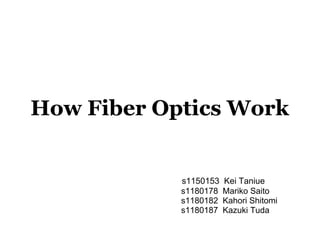
Document
- 1. How Fiber Optics Work s1150153 Kei Taniue s1180178 Mariko Saito s1180182 Kahori Shitomi s1180187 Kazuki Tuda
- 2. How Fiber Optics Work Introduction Fiber optics are long, thin strands of very pure glass about the diameter of a human hair that carry digital information over long distances. What are Fiber Optic? If you look closely at a single optical fiber, you will see that it has the following parts: Core - Thin glass center of the fiber where the light travels Cladding - Outer optical material surrounding the core that reflects the light back into the core Buffer coating - Plastic coating that protects the fiber from damage and moisture Optical fibers come in two types: Single-mode fibers - It have small cores (about 3.5 x 10-4 inches or 9 microns in diameter) and transmit infrared laser light (wavelength = 1,300 to 1,550 nanometers). Multi-mode fibers - It have larger cores (about 2.5 x 10-3 inches or 62.5 microns in diameter) and transmit infrared light (wavelength = 850 to 1,300 nm) from light-emitting diodes(LEDs).
- 3. How Does an Optical Fiber Transmit Light? ・Just point the beam straight down the hallway -- light travels in straight lines, so it is no problem. ・You could place a mirror at the bend to reflect the light beam around the corner and might line the walls with mirrors and angle the beam so that it bounces from side-to-side all along the hallway. ・The light in a fiber-optic cable travels through the core (hallway) by constantly bouncing from the cladding (mirror-lined walls), a principle called total internal reflection. Diagram of total reflection in an optical fiber ・However, some of the light signal degrades within the fiber, mostly due to impurities in the glass.
- 4. A Fiber-Optic Relay System An example to understand how optical fibers are used in communications systems World War II movie or documentary where two naval ships in a fleet need to communicate with each other while maintaining radio silence or on stormy seas. One ship pulls up alongside the other. The captain of one ship sends a message to a sailor on deck. The sailor translates the message into Morse code (dots and dashes) and uses a signal light (floodlight with a venetian blind type shutter on it) to send the message to the other ship. A sailor on the deck of the other ship sees the Morse code message, decodes it into English and sends the message up to the captain. Fiber-optic relay systems consist of the following: Transmitter - Produces and encodes the light signals Optical fiber - Conducts the light signals over a distance Optical regenerator - May be necessary to boost the light signal (for long distances) Optical receiver - Receives and decodes the light signals
- 5. Physics of Total Internal Reflection When light passes from a medium with one index of refraction (m1) to another medium with a lower index of refraction (m2), it bends or refracts away from an imaginary line perpendicular to the surface (normal line). In physics, the critical angle is described with respect to the normal line. In fiber optics, the critical angle is described with respect to the parallel axis running down the middle of the fiber. Therefore, the fiber-optic critical angle = (90 degrees - physics critical angle). In an optical fiber, the light travels through the core (m1, high index of refraction) by constantly reflecting from the cladding (m2, lower index of refraction) because the angle of the light is always greater than the critical angle. Total internal reflection in an optical fiber
- 6. Advantages of Fiber Optics Less expensive - Several miles of optical cable can be made cheaper than equivalent lengths of copper wire. This saves your provider (cable TV, Internet) and you money. Thinner - Optical fibers can be drawn to smaller diameters than copper wire. Higher carrying capacity - Because optical fibers are thinner than copper wires, more fibers can be bundled into a given-diameter cable than copper wires. This allows more phone lines to go over the same cable or more channels to come through the cable into your cable TV box. Less signal degradation - The loss of signal in optical fiber is less than in copper wire. Light signals - Unlike electrical signals in copper wires, light signals from one fiber do not interfere with those of other fibers in the same cable. This means clearer phone conversations or TV reception. Low power - Because signals in optical fibers degrade less, lower-power transmitters can be used instead of the high-voltage electrical transmitters needed for copper wires. Again, this saves your provider and you money. Digital signals - Optical fibers are ideally suited for carrying digital information, which is especially useful in computer networks. ...and so on